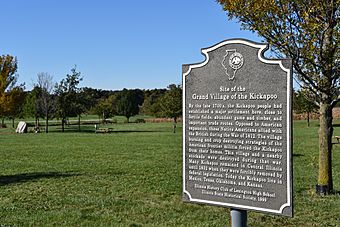Grand Village of the Kickapoo facts for kids
Quick facts for kids |
|
|
Warren Bane Site
|
|
 |
|
| Location | Ellsworth, McLean County, Illinois |
|---|---|
| Area | 70.7 acres (28.6 ha) |
| NRHP reference No. | 82002588 |
| Added to NRHP | March 19, 1982 |
The Grand Village of the Kickapoo is an important historical site in McLean County, Illinois. It was once a large village of the Kickapoo people, a Native American tribe. The site also includes the Warren Bane Site, which was a strong fort built to protect the village.
Contents
The Grand Village of the Kickapoo
The Grand Village of the Kickapoo was a home for many Kickapoo people for a long time. It was a place where they lived, worked, and raised their families. The village was located in a rural area of Illinois.
What Was the Village Like?
Life in the village likely involved hunting, farming, and trading. The Kickapoo people were skilled at living off the land. They built homes and created a community that thrived for many years.
Why Was the Fort Built?
Around 1750, a fort was built at the village site. This fort, known as the Warren Bane Site, was made to defend the village. It helped protect the Kickapoo people from attacks by other groups or armies.
When Did the Village End?
The Grand Village of the Kickapoo was used until 1813. In that year, the U.S. Army burned the village. This event marked the end of the village as a living community.
Protecting History
The Warren Bane Site is now recognized as a very important historical place. It helps us learn about the Kickapoo people and their history in Illinois.
What is the National Register of Historic Places?
The National Register of Historic Places is a list of places in the United States that are important to history. When a site is added to this list, it means it's worth protecting. The Warren Bane Site was added to this list in 1982.
Why is This Site Protected?
The exact location of the Warren Bane Site is kept secret. This is done to protect it from harm. People might try to damage the site or take things from it. Keeping the address private helps keep this important piece of history safe for everyone.



